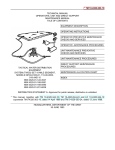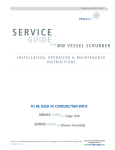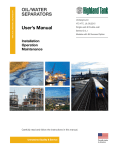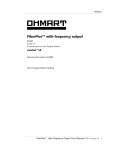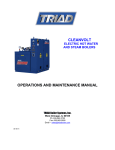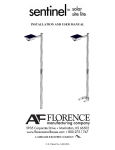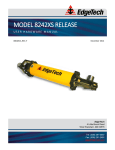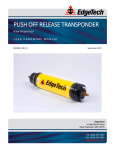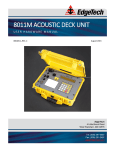Download CALORIQUE THERMOLAR THS-206 Specifications
Transcript
Thermolar® Tank Temperature Maintenance System Installation & Operation Manual for Systems Employing THS-106 or THS-206 Electronic Controller. Precise, efficient temperature maintenance for all types of metal and plastic tanks. INTRODUCTION INTRODUCTION The Calorique Thermolar® Tank Temperature Maintenance System is a low heat-density warming system designed to safely and efficiently maintain the contents temperature of any tank. Ideal for process control, adhesive storage (etc.) the THERMOLAR system provides uniform heat that won’t scorch tank contents. Note The Thermolar System is designed for temperature maintenance only and typically will not provide sufficient heat to significantly raise the temperature of tank contents. When installed and operated in accordance with these instructions, the Thermolar system complies with National Electrical Code article 427. Failure to install and operate this system in accordance with the manufacturer’s instructions may result in an unsafe condition and constitutes a violation of the system warranty and voids that warranty. Note that the system must be installed on a branch circuit that is protected by a fault detector that is suitable for equipment protection. PARTS & SPECIFICATIONS PARTS — SUPPLIED BY CALORIQUE Cross check all parts with the System Components List to ensure that all parts are included and in good condition before beginning installation. Quantities and/or lengths are included in the System Components List. Confirm system voltage before connecting the system to power supply. Do not connect systems to any voltage other than that for which they were designed. The following specifications are generic to the Thermolar system. Complete specifications for the particular system being installed are included on the System Components List. Control Unit Systems operated at higher than designed voltage pose a risk of electric shock and/or fire. Systems operated at lower than designed voltage may not maintain temperature which could result in loss of or damage to contents. Included with the control unit are a strap for attaching it to the tank and two remote thermo-sensors with 20 foot/6 m leads. Voltage: THS-106: 120 Vac THS-206: 240 Vac Heating Elements Calorique Thermolar heating elements are factory assembled with an integral ground shield, adhesive backing and moisture-proof electrical connections. Width: 11 inches/280 mm Maximum Temperature: Do not expose any Thermolar heating element to temperatures in excess of 180°F/82°C. See pages 7 and 8 for maximum exposure temperatures of standard tank types. Lead Length: 8 feet/3.5 m PARTS — INSTALLER SUPPLIED Duct Tape Standard grade duct tape (or equivalent) rated for at least 170°F/76°C. Power Cable Used to run electrical power from branch circuit box to the control unit. The type and length are determined by local code and individual requirements of the installation. Tools General electrician’s tools, including screwdriver, linesmans pliers, wire cutter/stripper, etc. Insulation Thermal insulation of the type and thickness noted on the System Components List must be installed on the tank to ensure proper and safe operation. Do not cut or otherwise alter the Thermolar heating elements. PARTS & SPECIFICATIONS 1 2 Circuit Overcurrent Protection Fuse or circuit breaker rated for at least 120% of the system amperage rating. Fault Protection The power supply must include a fault detector suitable for equipment protection. This may be integral with the overcurrent protection. INSTALLATION Note For best results, insulate underneath the tank. If the underside will not be accessible after installation of the Thermolar system, then install insulation prior to final placement of the tank. Insulating underneath the tank will help avoid excessive heat loss, reducing operating expense and the risk of damage to sensitive contents. CONTROL UNIT 1. Determine the location of the control unit. • If the control unit will be positioned remotely from the tank, skip to the next section, Heating Elements. • Attaching the control unit temporarily to the tank wall at this time will aid in aligning the heating elements so that the power cords will reach the controller. • Installing the control unit at eye level will make completion and operation easier. 2. Slide the strap through the slots provided on the back of the control unit. 3. Run the strap around the tank and slip the free end into the buckle. 4. Position the box about 4 feet/1.2 m from the bottom of the tank and tighten the strap to hold it in place. INSTALLATION HEATING ELEMENTS 3 Note Do not install heating elements when the air and/or tank temperature is below 35°F/2°C. Below this temperature the adhesive backing initially may not stick properly. Once the heating elements have been secured in place for at least 24 hours, temperatures at or below 35°F/2°C will not adversely affect the adhesive. Attach heating elements to the tank sidewall using the adhesive backing provided. Hold the elements in position then, working around the tank, peel the release paper from them and press lightly into position. Do not install the elements over manways, fittings, pipes, ribs, channels, insulation or anything other than the smooth tank wall itself. Ensure that the entire element will be in smooth, direct contact with the surface of the tank. Note Press the elements lightly in place at this time in case they need to be repositioned later. Note The heating elements are most effective when placed as close to the bottom of the tank as possible. This will allow warmer material to flow upward, promoting convection currents and more even internal heating. 2. Repeat step 1 for each heating element. Note If any heating elements need to be moved, do so before the adhesive sets up. After a short time the heating elements can not be removed without seriously damaging them. 3. Once all of the elements are in place properly, firmly press the element/adhesive into place securing the elements to the tank. 4. Seal the edges of each element with duct tape. This will ensure that insulation does not come between the elements and the tank wall which could impede heat flow into the tank. Do not fold or overlap the heating elements. INSTALLATION 1. 4 THERMO-SENSORS 1. Using duct tape, attach the Over Limit thermo-sensor (marked with red) to the central area of the upper-most heating element. Locate the sensor approximately 1-1/2 ft/450 mm from the cord end of the heating element. 2. Using duct tape, attach the Maintenance thermo-sensor directly to the tank wall approximately 6 inches/150 mm from the bottom-most heating element. Over Limit Sensor Maintenance Sensor INSTALLATION CONTROL UNIT — ON TANK WALL If the control unit is located on the tank itself, finish tightening the strap so that the box is secured in place. Note Make sure that the strap does not cross any heating elements, power cords or thermosensor leads. CONTROL UNIT — REMOTE LOCATION If the control unit is located remotely from the tank, attach the control unit, using standard electrical practices, to any suitable surface, pole, etc. Note Standard lead lengths on the thermo-sensors and heating elements are 20 ft/6 m and 8 ft/2.5 m respectively. When locating the control unit, ensure that the thermo-sensor wires and heating element power cords are not stretched taut and do not cross over the heating elements. 5 ELECTRICAL CONNECTIONS 1. Measure and record the resistance of each heating element. Record the measured resistances on the label on the back of the control unit face plate. 2. Route all wiring to the control unit as shown in the following figure. Metal tanks must be properly grounded before operating the system. Do not run power cords or thermosensor wires over heating elements. The over-limit sensor wire may be run over the heating element to which it is attached, but only for the shortest distance possible. Input Power When routing the wiring, include the small “J” curves to the lowest point of each wire. This will help to ensure that any water that penetrates the insulation does not reach the heating elements. 3. Secure all wiring in place to the side of the tank using duct tape. 4. Connect each heating element and the thermo-sensors to the appropriate terminal connections of the control unit according to the following diagram. Note Cut wires to length, as necessary. 5. Run power supply cable from the circuit breaker box to the control unit and make the connections to the power supply connectors inside the control unit. Note Local codes may require the use of an intermediary junction/switch box. 6. Attach remote alarms, if applicable, to the remote alarm relay points (shown on the wiring diagram on the next page). • Two alarm relays are provided that operate in the event that either temperature set for over-limit or low-limit is reached. • Note that the alarm relays do not generate an alarm signal. External power for the alarms must be provided. • Each relay terminal offers the option of a normally open (NO) or normally closed (NC) switch. Do not use both settings for the same relay terminal. Some thermo-sensors cables may include a ground wire. Do not connect thermo-sensor ground wires to the common line voltage ground. Make sure that power is turned off before working with the input power cable. Do not turn on power to the system unless there is contents in the tank. INSTALLATION NOTE 6 Over Limit Sensor Input Power Maintenance Sensor INSULATION Insulate the tank using the type and thickness insulation indicated on the System Component List. This insulation factor has been used to calculate the heating load required by the system: using less insulation may result in contents damage. Note Make sure that the control unit cover is securely in place before insulation is applied to the tank to ensure that no insulation gets into the control unit itself. Note If using blown-on insulation, create a dam around the control unit cover to ensure that it may be removed to allow for programming and the indicator lights to be seen. OPERATION PROGRAMMING OPERATION The programmable controller provides four different user-settable parameters Maintenance Temperature: Differential: Over-Limit Temperature: Low-Limit Temperature: The desired contents temperature. The precision of temperature control. The highest temperature that the heating elements, the tank contents or the tank itself should reach. The lowest allowable contents temperature. 7 The over-limit and low-limit temperatures are used in conjunction with the on-board indicator lights and/or remote alarms to indicate a fault situation. If the over-limit temperature is reached, power to all elements will be shut off. Note The control unit will normally be preprogrammed with the temperatures specified when the system was ordered. Before operating the system, confirm the temperature programming. To set temperatures: Press the Scroll button one or more times until the desired function setting LED is lit. The LCD display now indicates the current function setting. 2. Use the L and M buttons to set the temperature higher or lower than the current setting. See the following section, Operating Temperatures, for a list of acceptable temperatures. Note Set the over-limit temperature at least 10°F/5°C higher than the maintenance temperature. 3. Press the Scroll button one or more times to either highlight another function or until all function lights are out, which returns the control unit to operating mode. MAXIMUM OPERATING TEMPERATURES Metal Tanks Maintenance Temperature: Over Limit Temperature: Low Limit Temperature: up to 160°F/70°C up to 170°F/75°C up to 155°F/65°C Crosslinked Polyethylene Tanks Maintenance Temperature: Over Limit Temperature: Low Limit Temperature: up to 130°F/55°C up to 140°F/60°C up to 125°F/50°C When programming the control unit is complete, ensure that all function lights are out. When the system is in programming mode (when one of the function lights is lit) the heating elements will still operate but there is a possibility that the programming may be changed inadvertently. Do not exceed the temperatures noted at left. Temperature settings above those listed may result in damage to the Thermolar system, the tank and/or the tank contents. Ensure that the temperature of the contents being loaded into a tank does not exceed the maximum temperature setting as noted at left. OPERATION 1. 8 MAXIMUM OPERATING TEMPERATURES (continued) Linear Polyethylene Tanks Maintenance Temperature: Over Limit Temperature: Low Limit Temperature: up to 120°F/50°C up to 130°F/55°C up to 115°F/45°C OPERATION Under normal operating conditions, no adjustment is necessary. It is suggested that the liquid level within the tank be maintained to at least the level of the highest heating element. This will ensure that each heating element is operating at its peak efficiency. TEMPERATURE ALARMS User intervention may be required if either the over-limit or low-limit alarm lights are illuminated or if remote alarms (if installed) are activated. Under these circumstances, check for the following indications: Note In normal operation, the over-limit temperature alarm and relay may occasionally be activated. If the over-limit alarm and relay remain on for more than 5 minutes at a time remedial action should be followed. • Does the system or exterior of the tank look damaged in any way? Determine the extent of the damage and contact Calorique technical support at (508) 291-4224 for possible corrective action. • Are the heating elements damaged? OPERATION To determine if the elements have been damaged: 1. Remove the system from power. 2. Disconnect each heating element from the terminal strip in the control unit. 3. If possible, visually inspect each element for obvious damage. 4. Using an accurate ohm or multimeter, determine the resistance of each element. These readings should be between the following (depending on voltage): 15840 high resistance (120 volt elements) = ———————— rated heat output in watts 9 13680 low resistance (120 volt elements) = ———————— rated heat output in watts 63360 high resistance (240 volt elements) = ———————— rated heat output in watts 54720 low resistance (240 volt elements) = ———————— rated heat output in watts The number of watts is given on the System Components List. If the resistance reading does not fall within the above numbers, contact Calorique technical support at (508) 291-4224 for remedies. • • Is the input voltage to the heating elements correct? • The design voltage is clearly marked on the faceplate of the control unit. Operating heating elements at greater than their design voltage can cause overheating of the elements and tank contents. Operating elements at lower than their design voltage may result in insufficient heat output to properly maintain contents temperature. • If the input voltage is not correct: disconnect the system from power and contact Calorique technical support. Is there material in the tank? • An empty tank, or a tank with a contents level below the level of the heating elements will, in a short time, result in an over-temperature situation. • If no: either fill the tank or shut off the heating system until the tank has been filled. • If yes: check to see if the material is thick and sludge-like. If it is, then mechanical agitation (mixing) may be required to ensure that heat is evenly distributed through the contents. If the material has a low viscosity (like water), proceed to the next troubleshooting question. Is each heating element operating? Check the Heater Circuits Active indicator lights. When the Main Heater Relay light is illuminated, each heater circuit light should also be lit (unless there is no heating element attached to the particular circuit). Ensure that any non-operating element is correctly wired into the control unit. If it is (they are): contact Calorique technical support. • If the above remedies do not fix the problem, call Calorique technical support at (508) 291-4224 for additional help. OPERATION • Calorique Ltd. 2380 Cranberry Highway West Wareham, MA 02576, USA (508) 291-4224 • (508) 291-2299 fax Copyright © 1997-2003 Calorique, Ltd. All Rights Reserved. Printed in USA CM2001 — 2003-04













